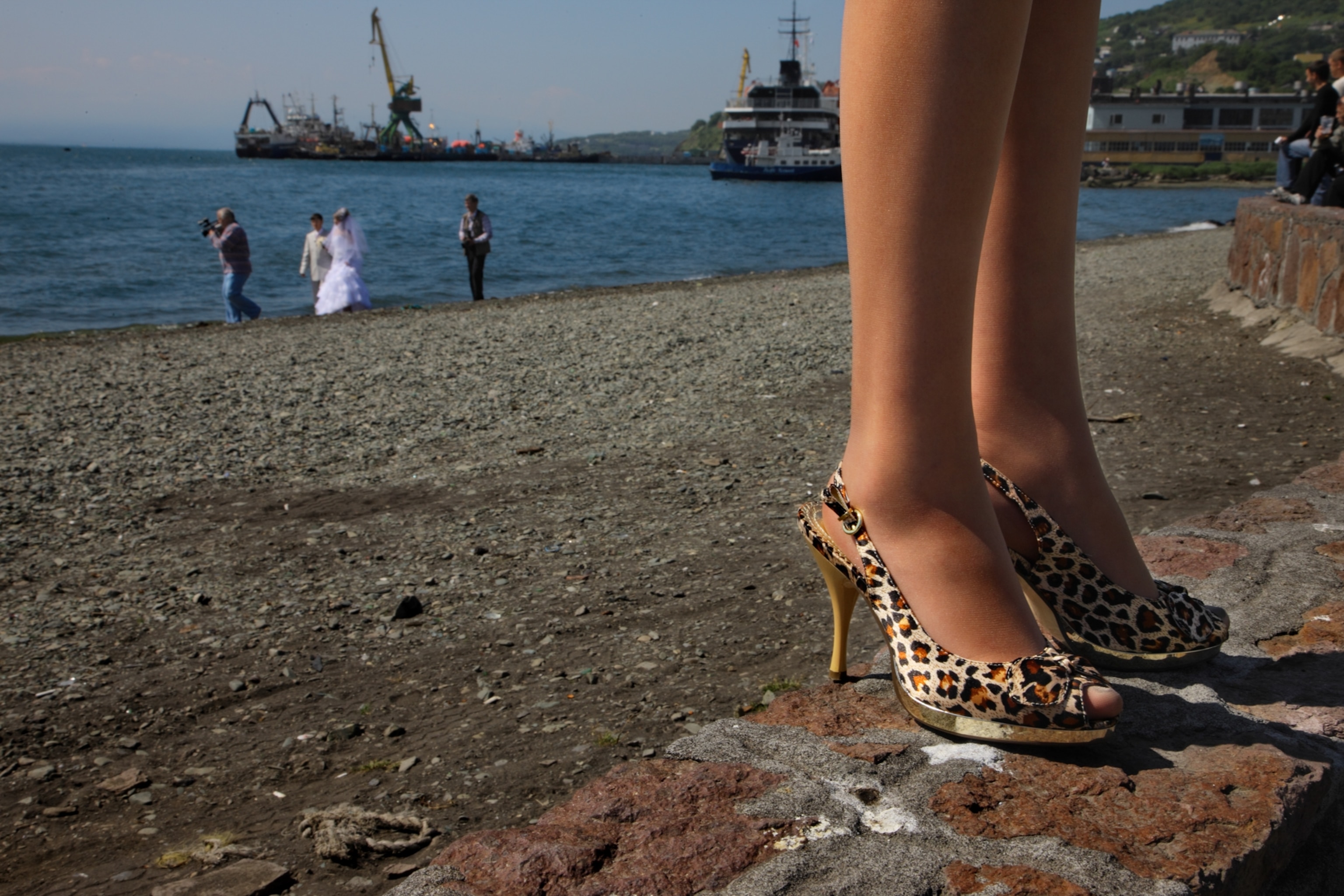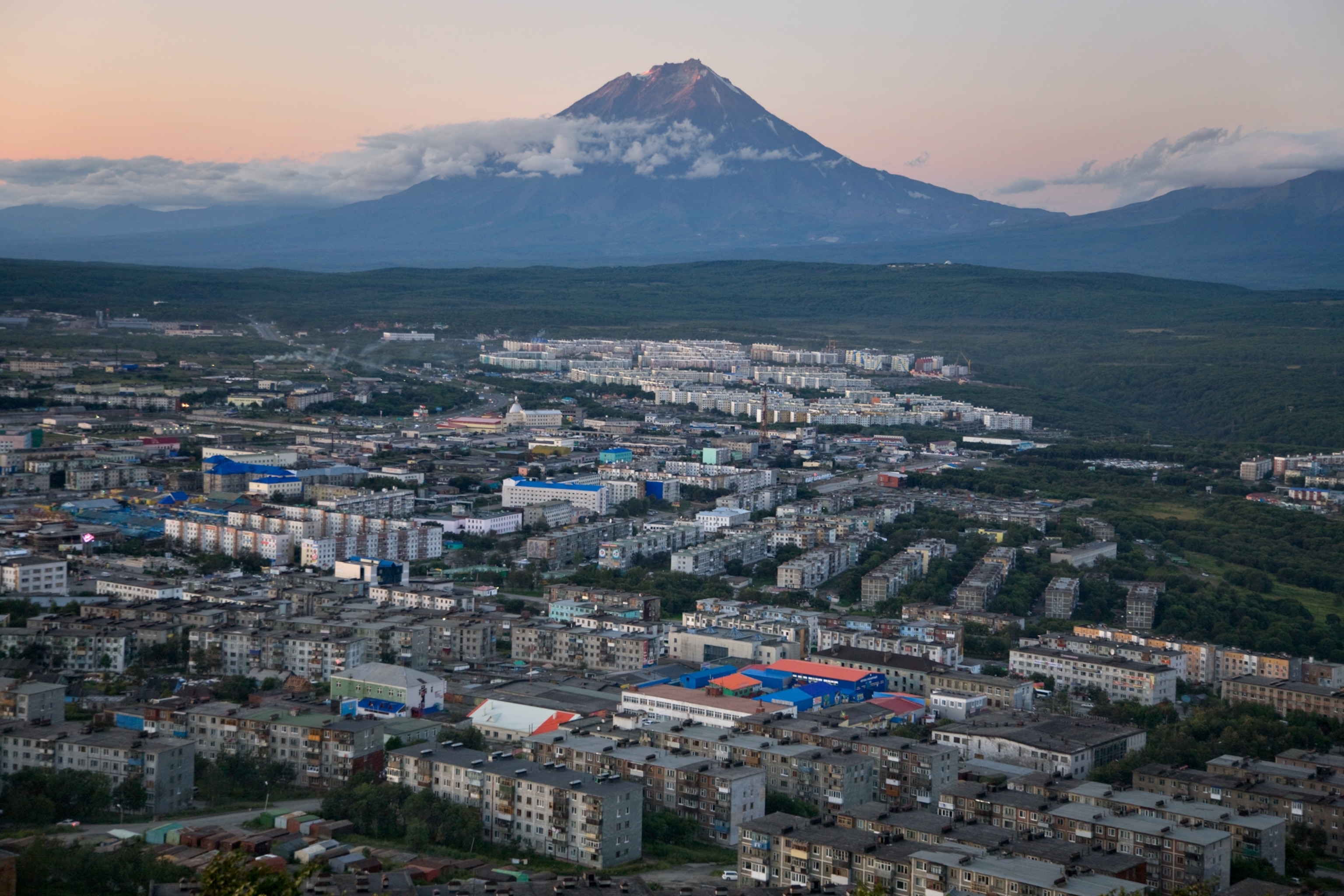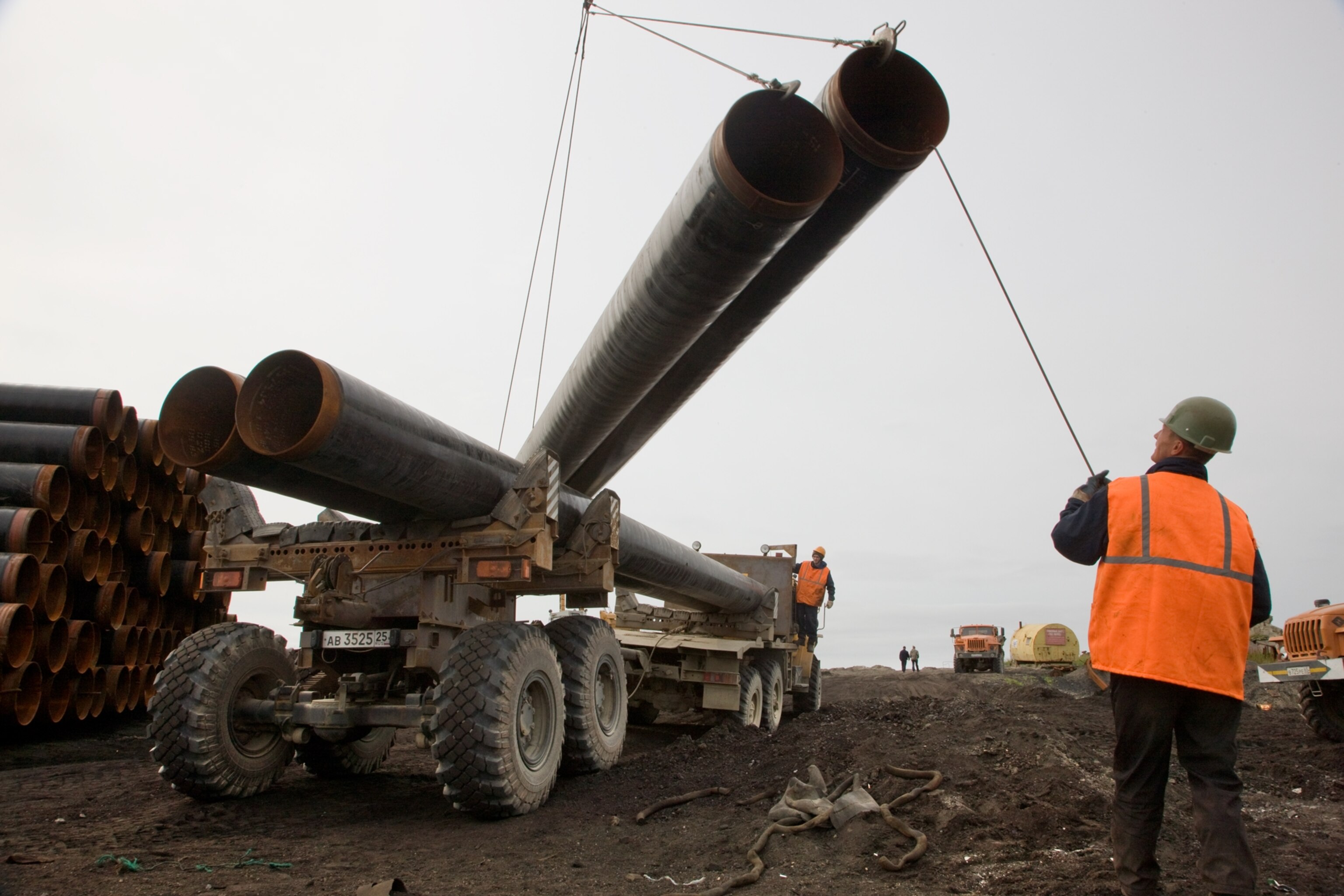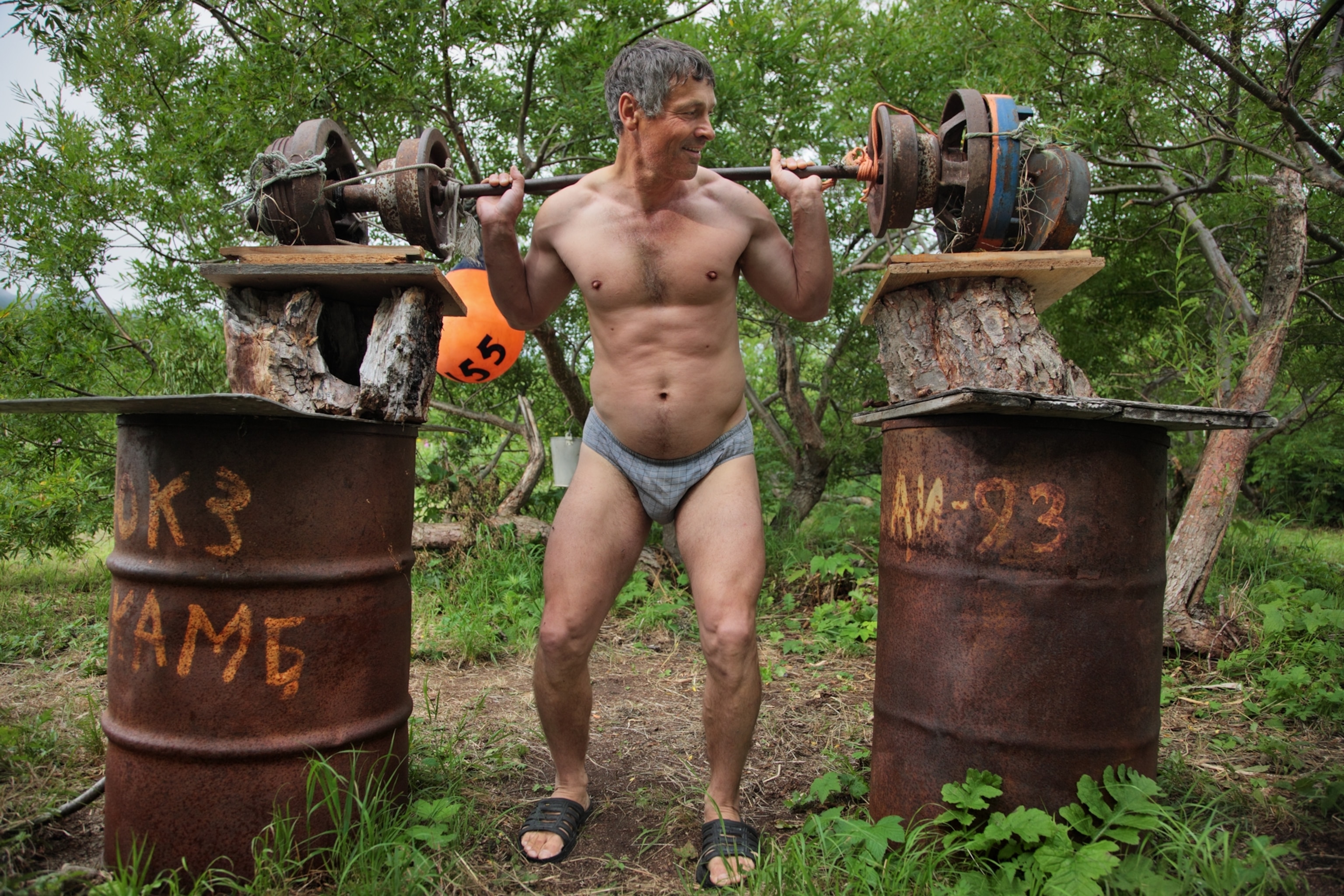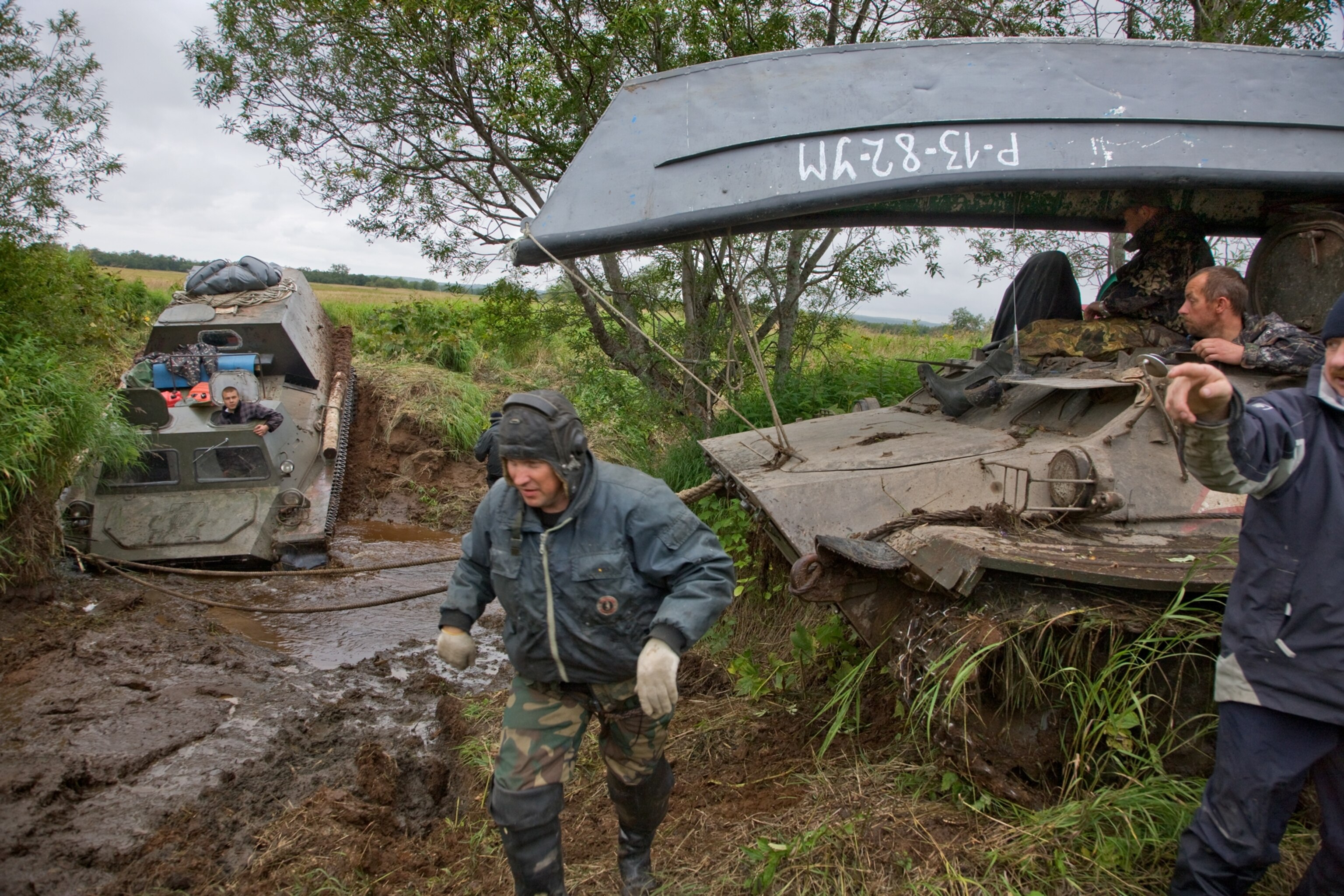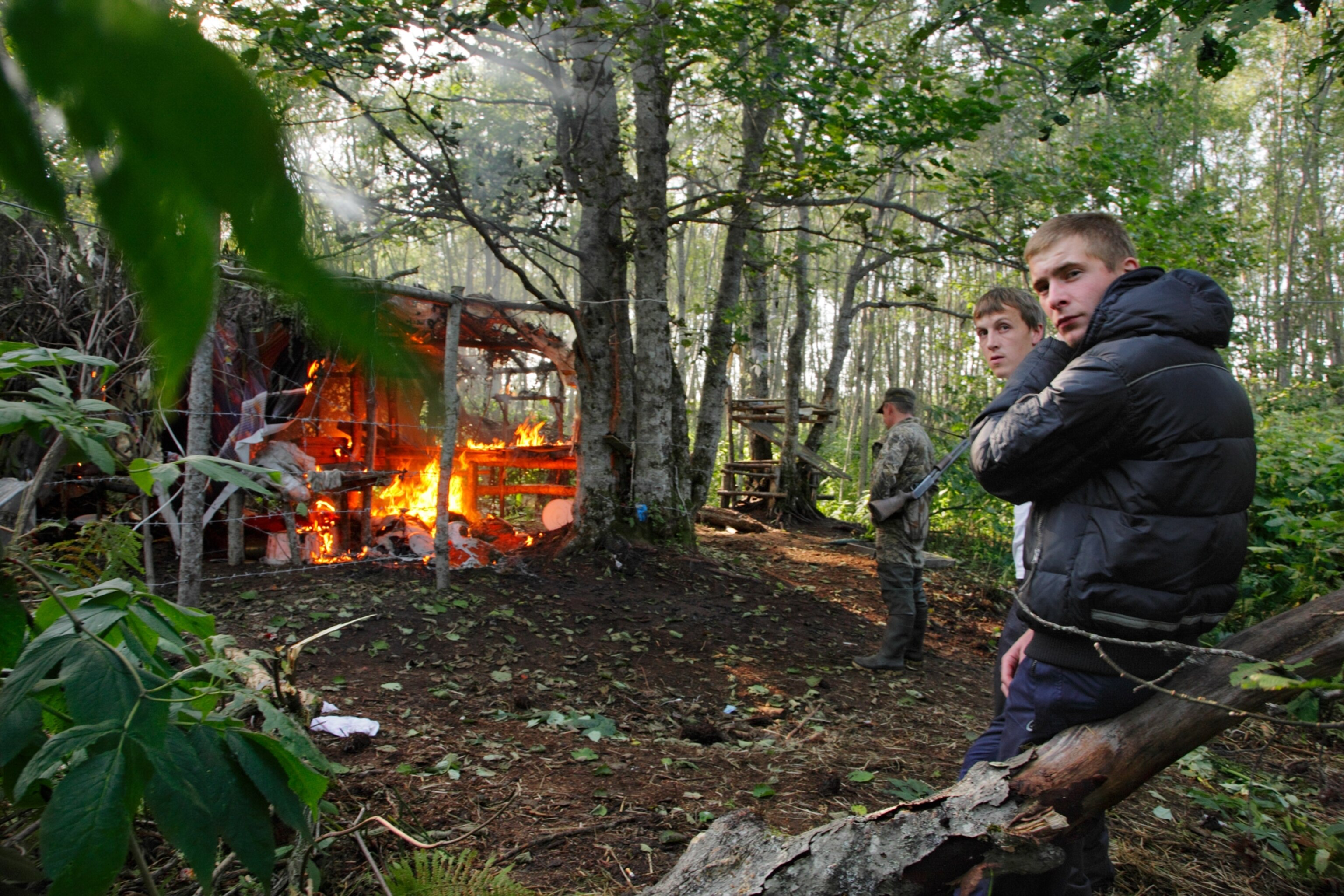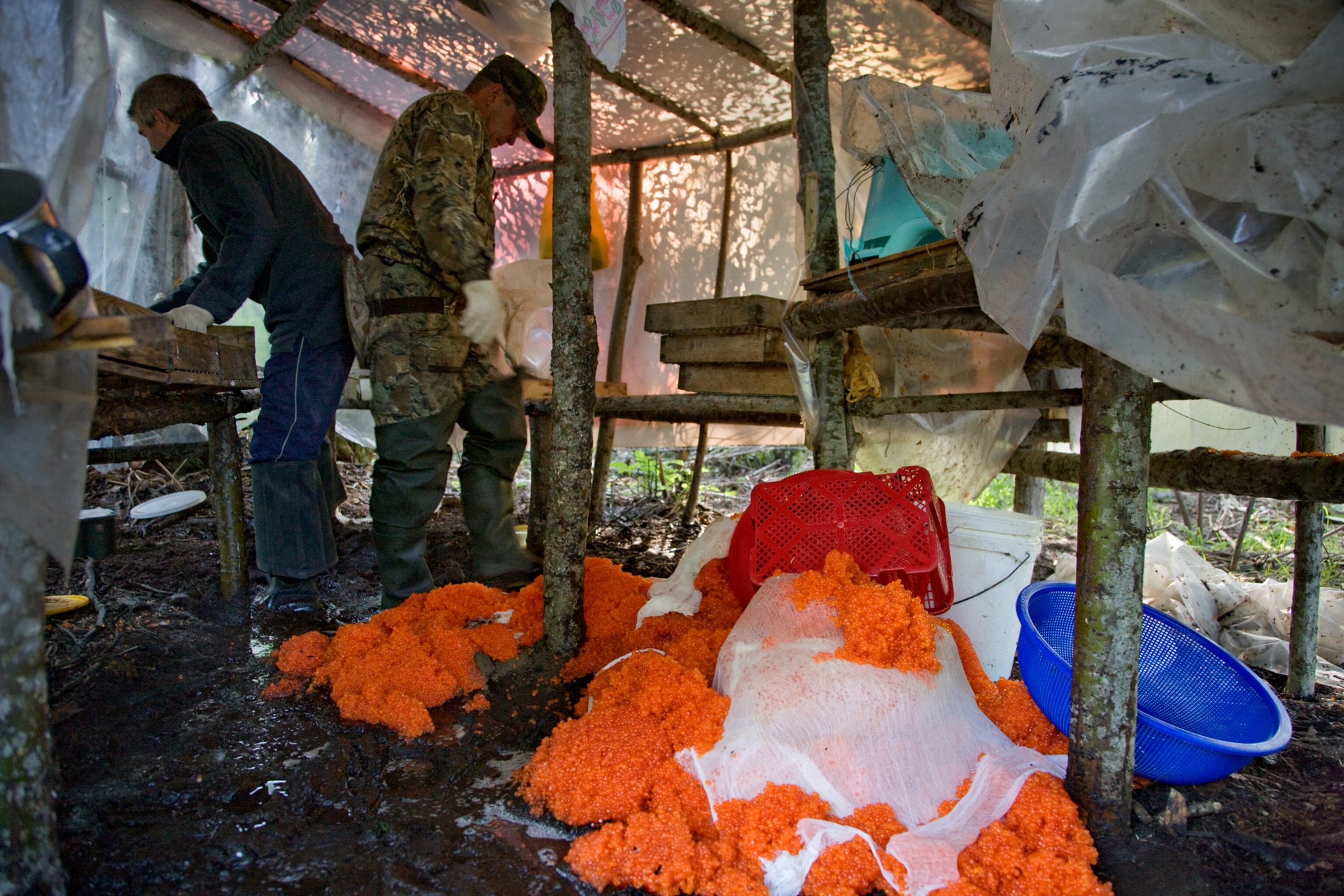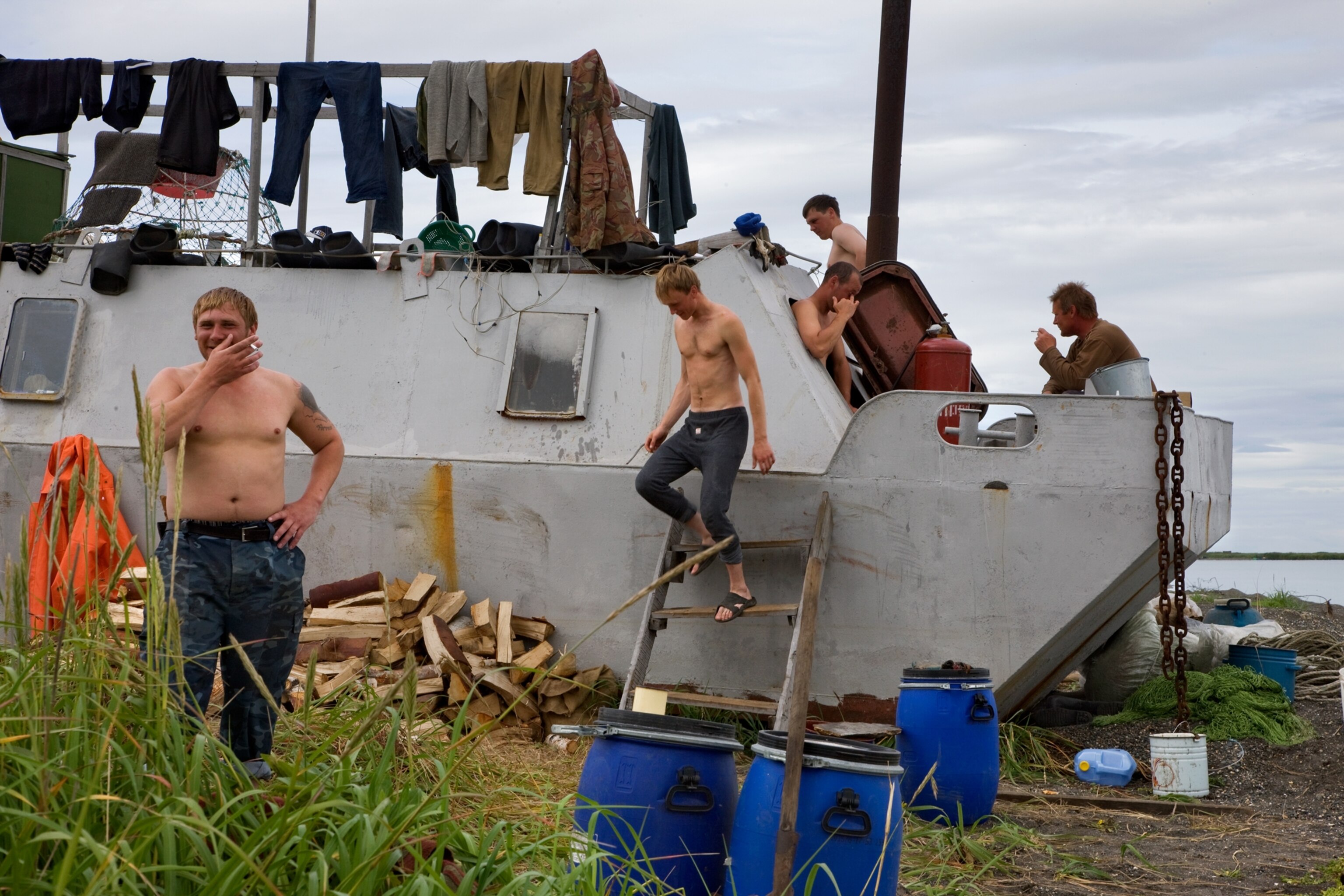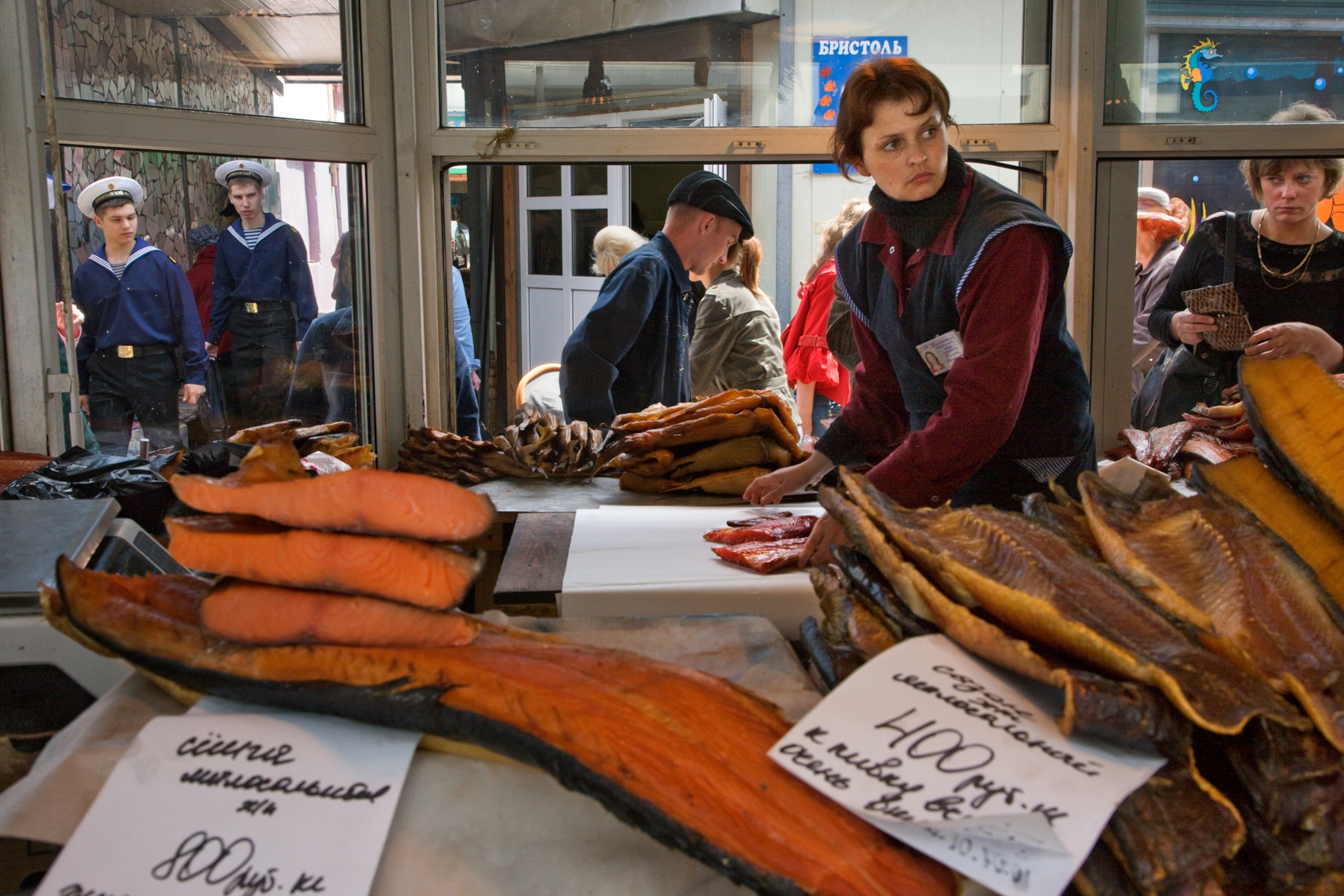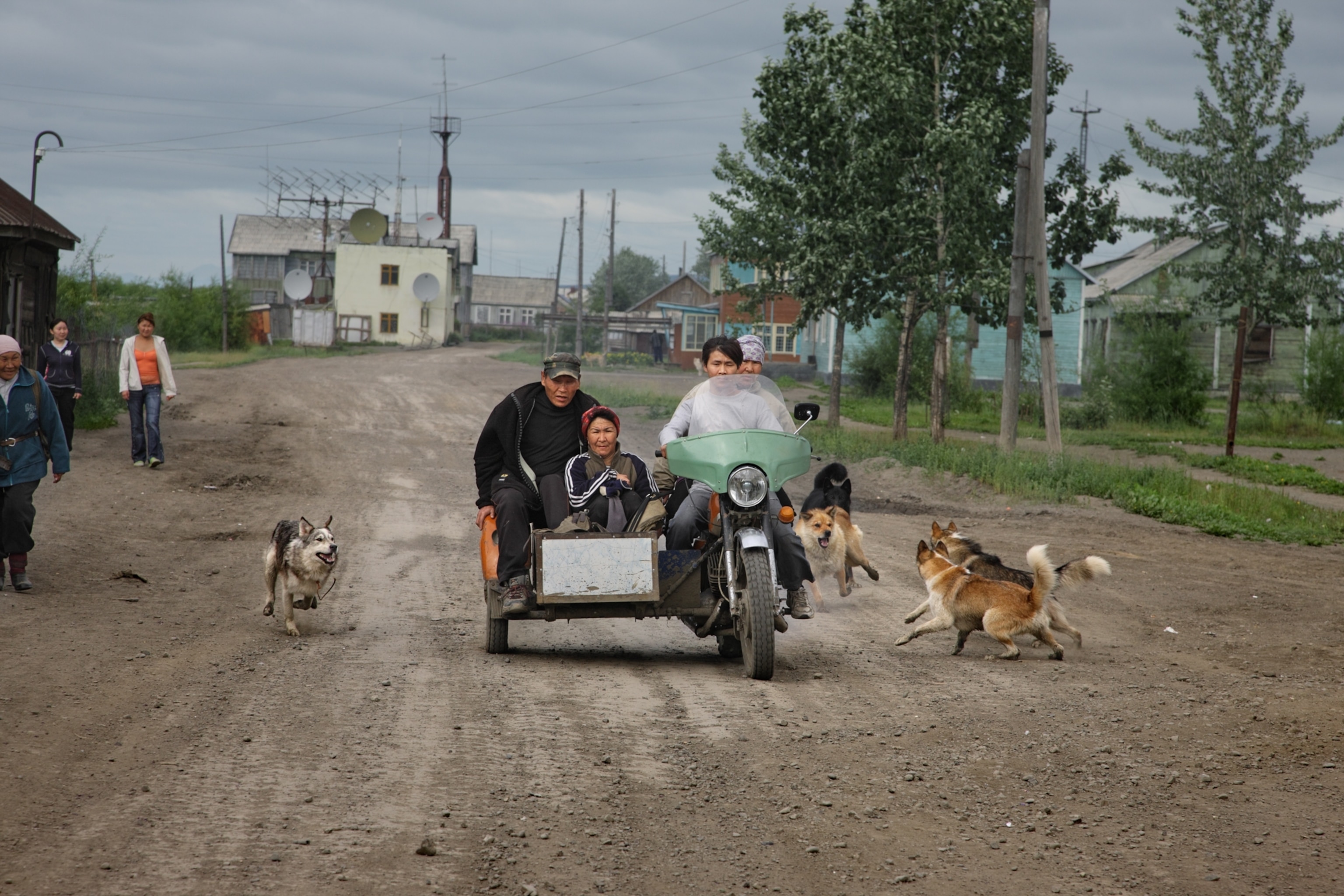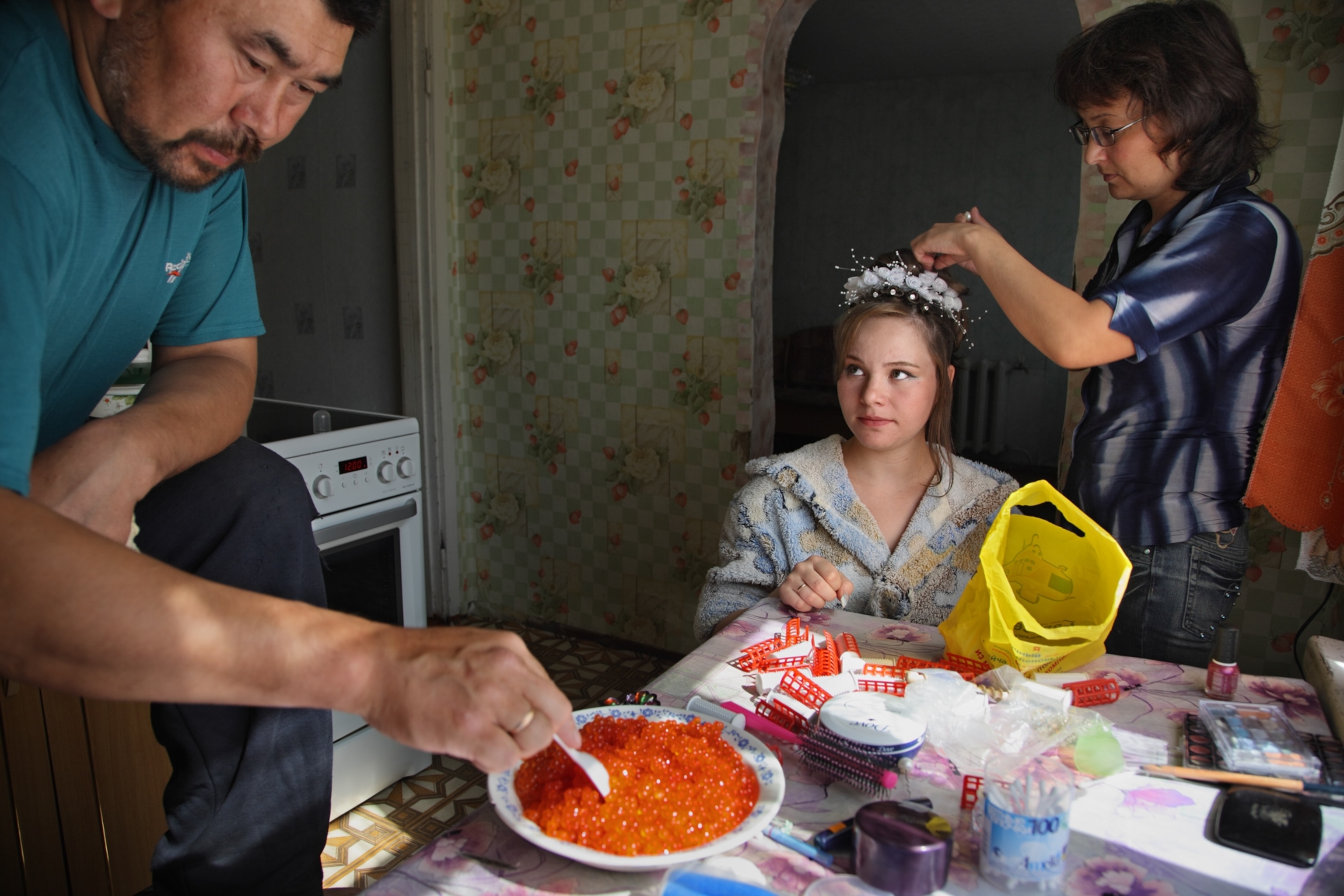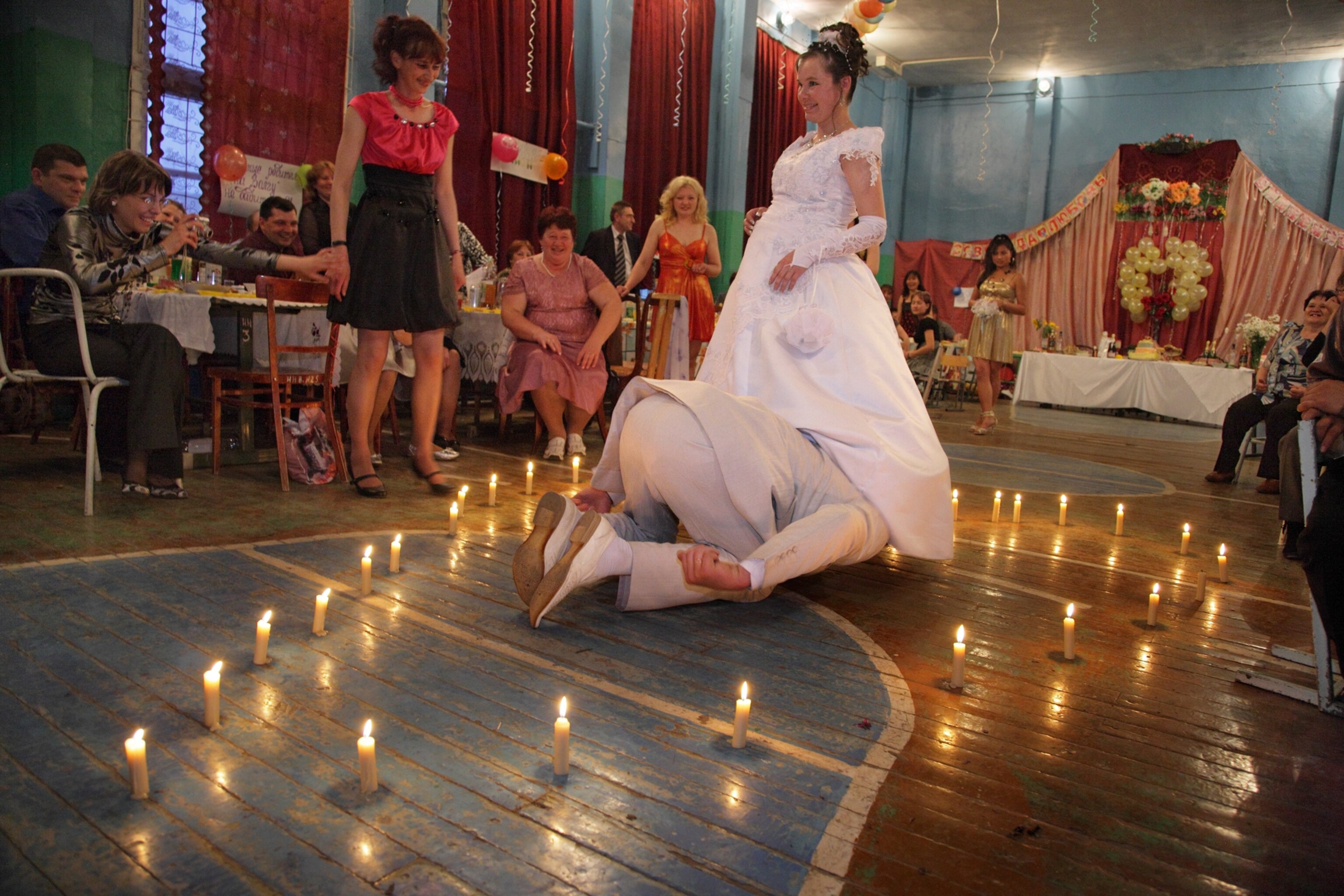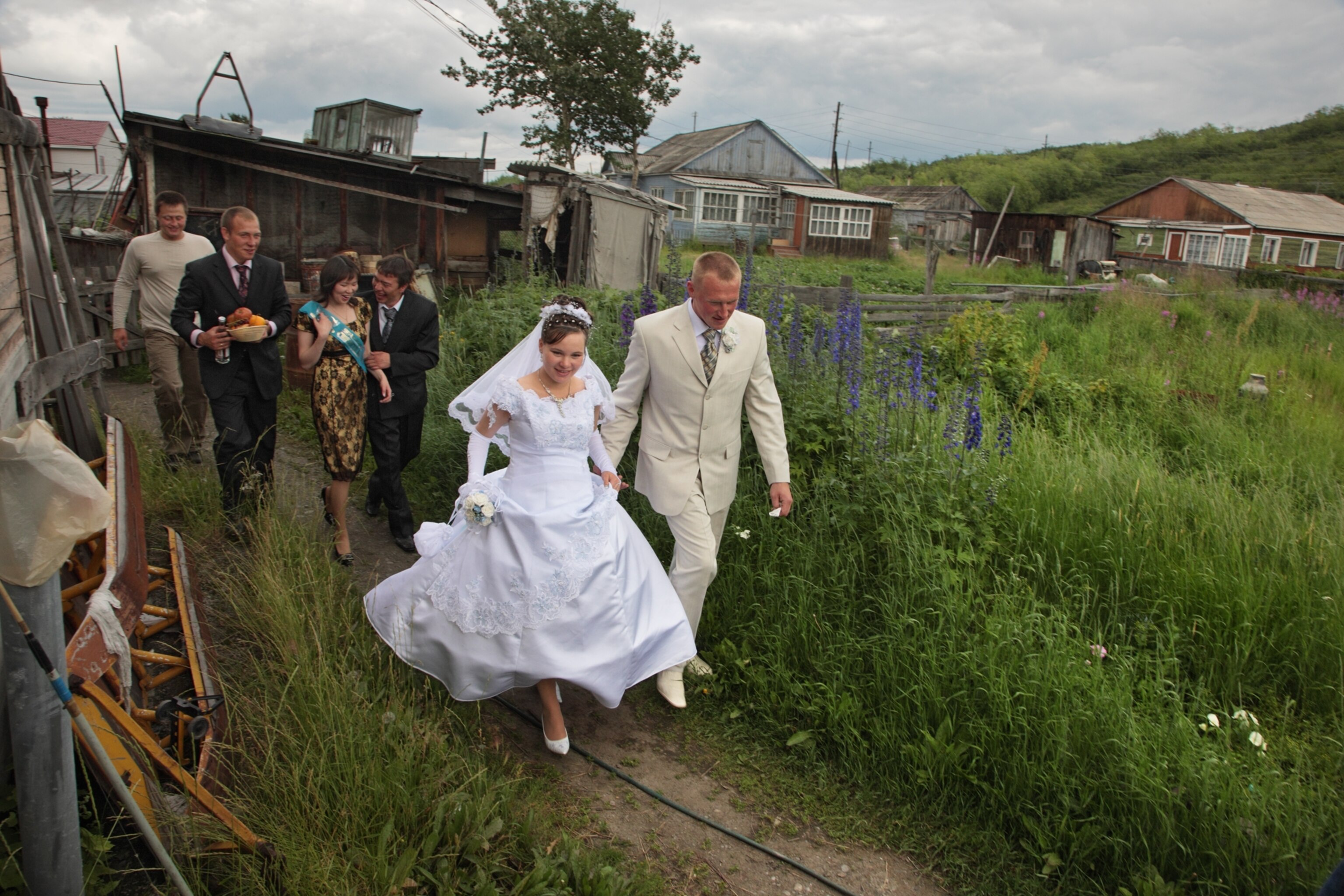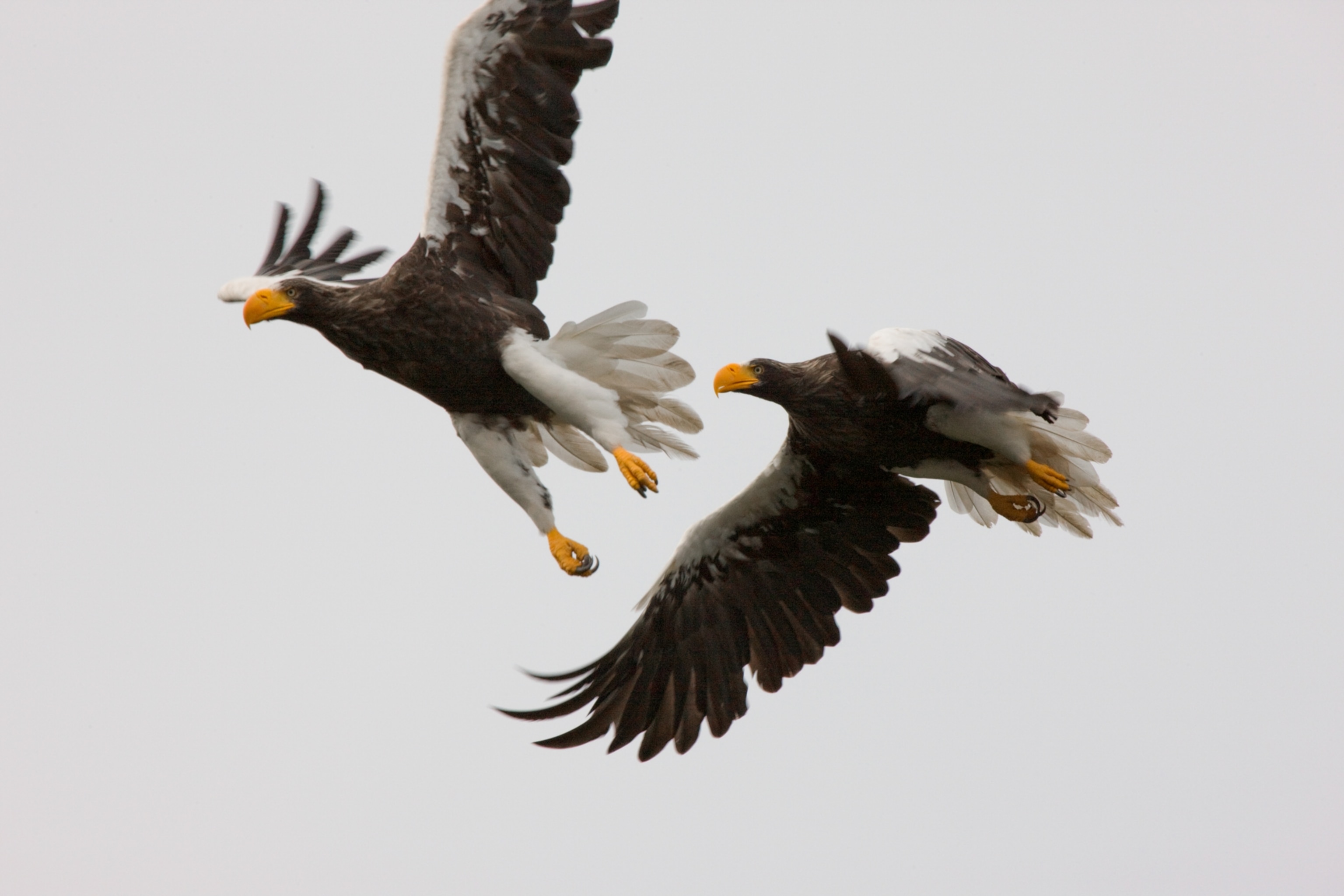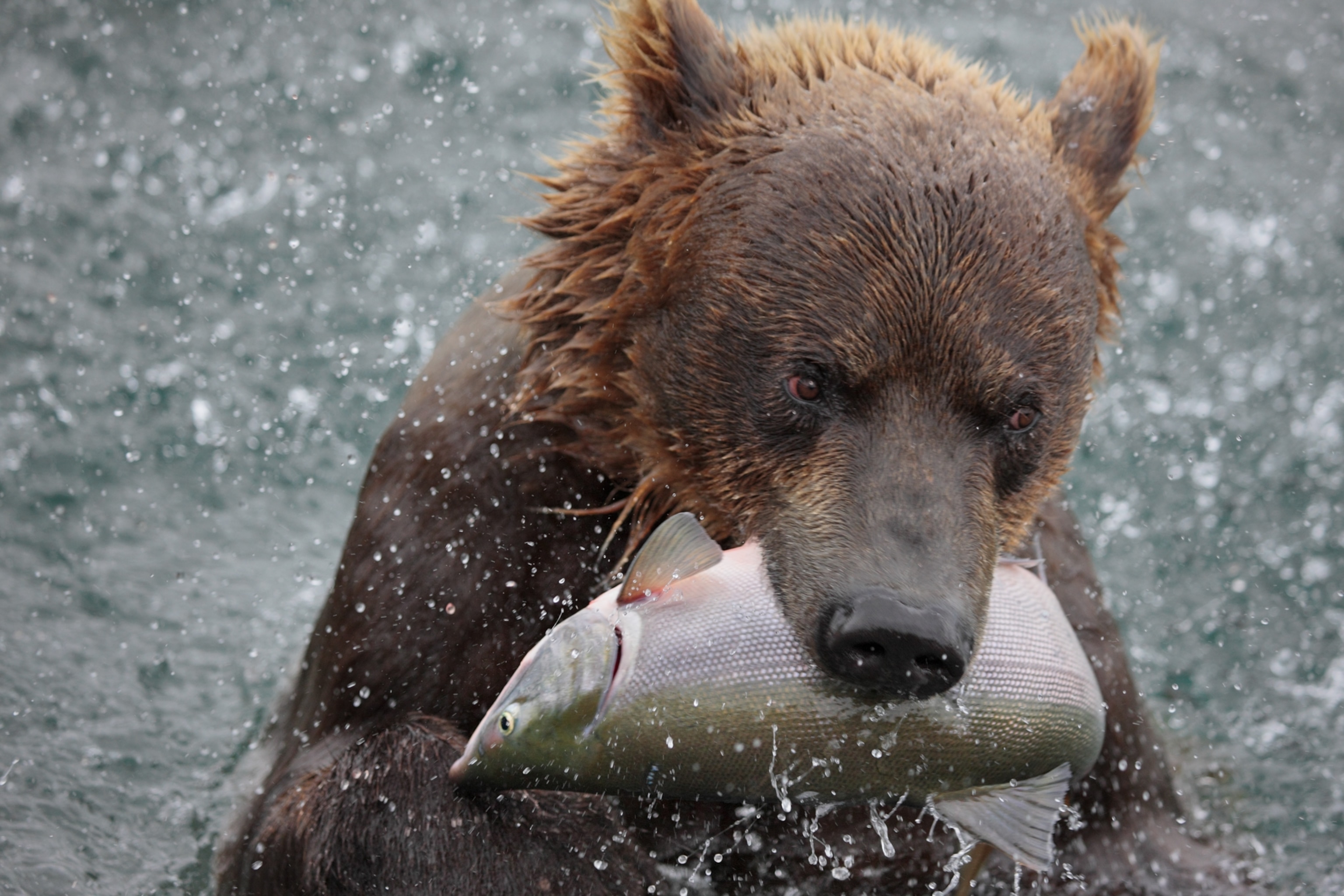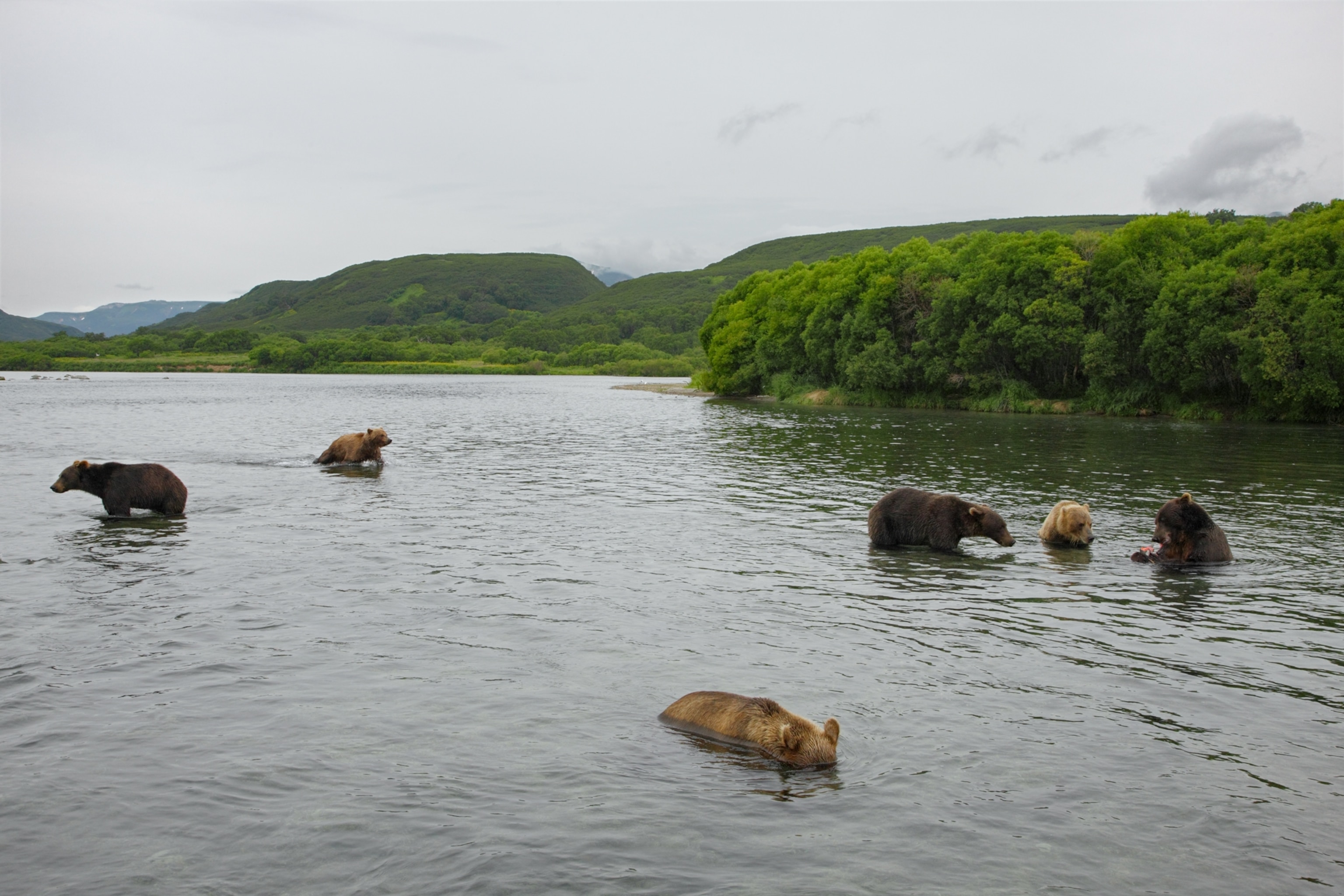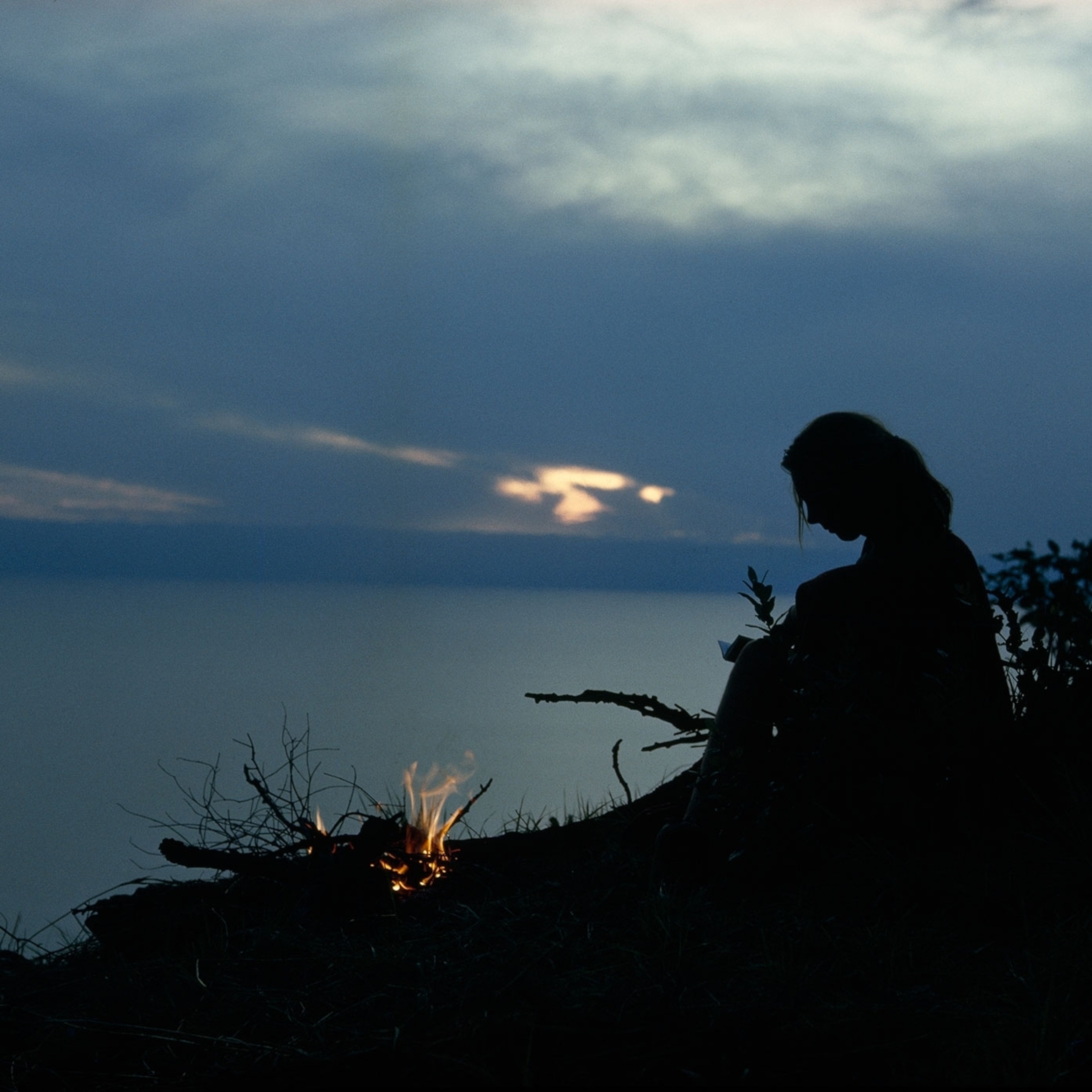Where the Salmon Rule
Russia’s remote Kamchatka Peninsula has some of the richest salmon runs in the Pacific, sustaining animals and communities. Now the fish need help.
The Kamchatka Peninsula, rugged and remote, is a vast blade of land stabbing southwestward through cold seas from the mainland of northeastern Russia. Its coastline is scalloped like the edges of an obsidian dagger. Its highlands rise to cone-shaped volcanic peaks, snow-streaked in summer, and to ridges of bare, gray rock. Its gentler slopes are upholstered in boreal greens. It's a wild place, in which brown bears and Steller's sea-eagles thrive on a diet rich in fatty fish. About 350,000 people inhabit Kamchatka Krai (its label as a governmental region), and they too are highly dependent on fish. In fact, you can't begin to understand Kamchatka without considering one extraordinary genus: Oncorhynchus, encompassing the six species of Pacific salmon.
("Extinct" Salmon Discovered in Japanese Lake)
Then again, it might also be said: You can't understand the status and prospects of Oncorhynchus on Earth without considering Kamchatka, the secret outback where at least 20 percent of all wild Pacific salmon go to spawn.
Although larger than California, the peninsula has less than 200 miles of paved roads. The capital is Petropavlovsk-Kamchatsky, on the southeastern coast, containing half the total population. Across a nicely protective bay sits the Rybachiy Nuclear Submarine Base, Russia's largest, in support of which the city grew during Soviet times, when the entire peninsula was a closed military region. Travel to most other parts of Kamchatka is still difficult for anyone who doesn't have access to an Mi-8 helicopter. But there is a modest network of gravel roads, and one of those winds upstream along a narrow waterway called the Bystraya River, amid the southern Central Range, to the Malki salmon hatchery, a complex of low buildings surrounded by trees.
Hatchery operations began in Kamchatka in 1914, during the twilight of the tsars, but this facility was established just three decades ago. In a lounge room off the entryway, someone hung a poster, declaring in Russian: "Kamchatka was created by nature as if for the very reproduction of salmon." That sounds almost like a myth of origins, but the poster listed some nonmythic contributing factors: Permafrost is largely absent, rain is abundant, drainage is good and steady, and because of Kamchatka's isolation from mainland river systems, its streams are relatively depauperate of other freshwater fish, leavingOncorhynchus species to face few competitors and predators. The poster was right. Judged on physical and ecological grounds, it's salmon heaven.
Unfortunately, those aren't the only factors that apply. Kamchatka's tottering post-Soviet economy, fisheries-management decisions (and the politics behind them), and how those decisions are enforced will determine the fate of Kamchatka's salmon runs, driving them toward a future that lies somewhere between two extremes. Within a relatively short time, maybe ten years or twenty, the phrase "Kamchatka salmon" could represent a byword for good resource governance and a green brand, reflecting the greatest success story in the history of fisheries management. Or that phrase could memorialize the saddest and most unnecessarily squandered conservation opportunity of the early 21st century. Think: American alligator. Or think: passenger pigeon. At present, the situation is fluid.
Life is hard enough for a salmon, even without politics and economics. Consider the 1.2 million fry released each spring from the Malki hatchery. Roughly five inches long after their first months of growth, they face no easy path from infancy to adulthood. What they face, rather, is a high likelihood of early death. For starters, the hatchery lies about a hundred miles (as a fish swims) from the sea. Each little salmon must descend the Bystraya River to its confluence with a larger river, the Bolshaya. Eluding all manner of freshwater perils on the Bolshaya, it must gradually metamorphose into a different sort of fish, a smolt, capable of making the transition to life in salt water. From the mouth of the Bolshaya, on Kamchatka's west coast, it must enter the bigger world of the Sea of Okhotsk, a frigid but nourishing body of water between the peninsula and mainland Russia.
Then, for a period of two to five years (depending on the species), that fish must circulate through the Sea of Okhotsk or else southeastward around the peninsula's tip into the expanse of the Pacific. The fish might travel thousands of miles, finding its preferred food (mostly small squid and crustaceans) abundant but facing predation, competition, and other challenges of the marine environment. For instance, it might be caught in the open ocean by fishermen using enormous drift nets that trap everything in their path. If it survives these years of robust swimming and feeding, it will grow large, fat, and strong. That's the advantage of anadromy (a sea-run life history): The ocean years allow fast growth. Approaching sexual maturity, the fish will head homeward to spawn, using some combination of magnetic sensing and polarized light to find its way back to the Bolshaya River. From the estuary it will ascend upstream by smell, branching into the familiar Bystraya, and finally climbing through the same shallow riffles of the same smaller tributary that its parents ascended before it.
Thousands of eggs will be laid for every two adult fish that return. Unlike an Atlantic salmon or most other species of vertebrate, a Pacific salmon breeds once and then dies. Scientists call the phenomenon semelparity. For the rest of us: big-bang reproduction. After the adult has homed to its spawning stream, death follows sex as inexorably as digestion follows a meal. It's a life-history strategy, shaped by evolution over millions of years, that balances the costs of each spawning journey against the costs of reproductive effort, toward the goal of maximizing reproductive success. In plainer words: Since the likelihood of any fish surviving the whole journey not just once but twice is so slim, Pacific salmon exhaust themselves fatally—they breed themselves to death—at the first opportunity they get. Why hold back anything if you'll never have another chance?
So their lives enact a romantic but pitiless narrative. Their success rate is low, even under optimal circumstances. The miracle of salmon is that any of them manage to complete such an arduous cycle at all. And present circumstances on the Bolshaya River and its tributaries—though the wall poster at Malki didn't say so—are far from optimal.
Ludmila Sakharovskaya, director of the Malki hatchery, is a sweet-spirited woman with blond hair and silver glasses who has worked there since the early 1980s. She trained as a biologist in Irkutsk, a warmish city in south-central Siberia, before moving east to this severe outpost in search of a better livelihood. For almost three decades she has watched—she has lived, like a doting nanny—the cycles of salmon rearing, release, and return.
"Twenty years ago I remember lots of fish coming to this river," she told me, through a translator, on a crisp summer day, as we stood near her fish traps in a little tributary. Those traps were the end point for spawn-ready adults whose eggs and sperm would fuel the hatching and rearing operations of the hatchery. "A variety of species," Sakharovskaya said. "Now I don't see them."
The decline in the run of chinook, Oncorhynchus tshawytscha, has been especially severe, she said. These are deep-bodied and silvery creatures with purplish dorsal markings, largest of all salmon species, and therefore sometimes known as king salmon. Once they came in great, regal herds. Nowadays the Malki hatchery releases 850,000 chinook fry (as well as a lesser number of sockeye) annually, but not many adults return. What stops them? Two kinds of illegal harvest: overcatching (perelov is the Russian word) by licensed companies that have catch quotas but exceed them with impunity, and poaching by individuals or small crews, mostly for caviar, at concealed spots along the river. The poaching problem throughout Kamchatka is catastrophic in scale, totaling at least 120 million pounds of salmon annually, much of it controlled by criminal syndicates. A hatchery director can't fix that problem, Sakharovskaya noted, and the regulatory authorities evidently don't have the resources or the resolve to do it. So only the luckiest and most elusive of chinook reach their destiny here along the Bystraya. "We can almost count them on fingers," she said.
But the Bolshaya drainage is only one of many river systems on the peninsula, and its hatchery fish aren't representative of Kamchatka wild salmon. Circumstances elsewhere are different; threats, opportunities, regulations, and even bureaucratic structures all change year by year. The whole situation is as complicated as a nested set of matryoshka dolls—Putin containing Gorbachev containing Brezhnev containing Stalin. On the Kol River, for instance, which also drains to the west coast, there is no hatchery, no streamside road, and (so far) no tragedy of depleted runs. What the Kol represents is superb habitat, scarcely touched, and abundant runs of wild salmon, including all six species: chinook, sockeye, chum, coho, pink, and masu. Last year, over seven million fish returned to spawn, filling the Kol so fully that in some stretches salmon were packed side to side like paving bricks. The Kol also carries another distinction. By a 2006 decree of the Kamchatka government, that river (along with another nearby stream) became part of the Kol-Kekhta Regional Experimental Salmon Reserve, the world's first whole-basin refuge established for the conservation of Pacific salmon.
On the north bank now sits the Kol River Biostation, a cluster of simple wooden buildings that serves as base for a binational research effort, its field operations led by Kirill Kuzishchin of Moscow State University and his American colleague, Jack Stanford of the University of Montana. Kuzishchin, Stanford, and their team are studying the dynamics of the Kol ecosystem. They hope to address several big questions, including: How important are salmon to the health of the entire river ecosystem?
Kirill Kuzishchin is a burly man with a linebacker's neck, a sly smile, and a sharp scientific brain. He was raised on a farm near Moscow by his grandparents. At age four he caught his first fish and was evermore fascinated by things piscine; even now, as an associate professor in the ichthyology department at Moscow State, he loves to cast a line when collection of specimens is required. Among the chief lessons of his studies in freshwater ecology is that a river is more than its main channel. "The whole floodplain acts as one single organism," Kuzishchin told me during a late evening talk at the Kol station. Water flows not just downstream but from channel to channel, both on the surface and via the underground aquifer; leaves fall into the river from riparian trees and bushes, supplying food and mineral nutrients to aquatic insects and microbes; whole trees topple into the water, providing cover for fish. "Everything is connected," he said. "The faster the growth of the trees, the more of them falling down into the river, the more habitats we have."
But nutrients are continually lost from the upper reaches by the same gravitational pull that takes water, silt, and other material downstream. So why don't these rivers gradually lose productivity? The reason is upstream migration by millions of salmon, Kuzishchin explained. The fish themselves bring nutrients such as nitrogen and phosphorus, accumulated during the years at sea, and surrender those precious loads to the ecosystem as their bodies decay. One aspect of the fieldwork by his and Stanford's team is to gauge the amount of nutrients at the Kol headwaters that are delivered and redelivered by salmon.
The scientists do that by testing for a certain isotope of nitrogen, N-15, which is relatively rare compared with other forms of nitrogen but far more abundant in oceans than in rivers. High concentrations of N-15 in the Kol's water during the season after spawning and decay, and in the leaves of the willow and cottonwood trees lining the banks, reflect the fact that salmon are bringing nutrients upstream. It's a circular effect, Kuzishchin said. Take the salmon away (for instance, by overharvesting or by poaching), and the very leaves of the trees will be deprived of nitrogen. So will the microbes and insects that eat the leaves. The entire ecosystem will lose nutrients, possibly to the point that it could no longer support large runs of salmon, even if they were reintroduced. He repeated his ecological maxim: "Everything is connected."
Jack Stanford made the same point more bluntly: "If you harvest all your fish, you cannot have a productive system."
During a fieldwork excursion upstream from the station, I saw the Kol River's fecundity for myself. We ascended the main channel in motorized johnboats, then proceeded by foot, bashing across the jungly floodplain through a dense thicket of green plants, ten feet high but as delicate as celery, toward a side channel where the team would gather data. Kuzishchin led, chopping a corridor through the vegetation. It was mostly annual growth, consisting of thistle, nettle, cow parsnip, a white-flowered thing called Kamchatka meadowsweet, along with some grasses and ferns, together constituting a fast-growing floodplain assemblage known in Kamchatka as shelomainik. Finally we reached the little spring-fed channel, and as Kuzishchin and the others prepared to collect stream insects, algae, tiny fish, depth and flow readings, and willow leaves for nitrogen testing, I asked Stanford: What allows all this herby growth to spring up here, within such a short growing season, every year?
"In a word," he said, "salmon."
The salmon support a human ecosystem too. Near the mouth of the Bolshaya in a town called Ust-Bolsheretsk, a local official, Sergei Pasmurov, received me in a sparsely furnished office behind leather-padded doors. Beneath a photo of Vladimir Putin glowering down from behind a fern, Pasmurov offered a candid sketch of local history, which had been difficult recently.
Throughout the Soviet era, Ust-Bolsheretsk was a sizable agricultural center, a base for several large state farms that kept dairy cattle and grew turnips, tomatoes, and other vegetables in hothouses. Fishing was important also, with two fish-processing plants operating here. Population stood at about 15,000 for the district, including Ukrainians, Belorussians, Irkutsk Siberians—people from all over the U.S.S.R.—as well as indigenous Kamchatkans of the Itelmen ethnic group. Then, so abruptly, so harshly, came the end of the Soviet Union, without which those government-supported agricultural collectives failed. Suddenly there was an unfamiliar phenomenon, unemployment, and the population fell markedly. Dairy production dropped; vegetables became scarce. Pasmurov described the whole cascade of changes concisely and bundled them into one freighted word—razvalilsya—that my translator rendered as "the ruining." Fishing became, for lack of alternatives, the major economic activity of the district.
Fishing is seasonal, also cyclical, with up-and-down fluctuations from year to year. Even during a good year the river can't support everyone. Nonetheless, about 20 different companies or individuals are currently licensed to fish hereabouts, Pasmurov told me. The number of operators and the quota allotted to each are regulated—but not very stringently—by the Federal Agency of Fisheries. "It results in reducing fish," he said. Year to year, the runs are becoming smaller. Poaching also plays a role. The Bolshaya is a large river, easily accessible by road, therefore hard to protect. Access will become easier still, he added, now that a pipeline is being built to carry natural gas from the west coast to Petropavlovsk, crossing the Bystraya and a dozen other rivers (including the Kol, notwithstanding its protected-area status). The pipeline itself might be clean and leakproof, Pasmurov said, but the road built alongside it will invite more poaching, especially for caviar.
And caviar—valuable, preservable, portable—is what most poachers are after. "It's more convenient, easier to hide," he said. "You just salt it, put it in tanks, hide it in the forest." Later a truck, or even a helicopter, comes to collect the stash. Netting the salmon as they near their spawning streams, slitting them open, stripping out the eggs, tossing the carcasses aside as waste, a gang of poachers can do huge damage in a very short time. Their wholesale customers might even include some of the big fish-processing plants: laundering caviar for the open market.
I heard the same thing about caviar from other sources, including an ex-poacher on the Kol, who recalled that in the days before protection a small team could harvest five tons in a season. There might be 15 such teams on the river, each man making ten times the money he could in a legal fishing job. Do the arithmetic, and you find that at least 75 metric tons of illegally taken salmon eggs (each mass of eggs accounting for 20 percent of the female's body weight) amounts to more than three-quarters of a million pounds of illegally killed fish. The carcasses of those salmon are left for bears and other scavengers—a short-term benefit to the ecosystem, yes—but every salmon thus intercepted leaves no offspring to perpetuate the run.
On the lower Bolshaya I saw the business of salmon fishing as practiced legally. It was a chilly July morning. A dozen men stood ready in waders, wool caps, and rubber gloves as a net was stretched far out across the river's channel by motorboat, then swung gradually downstream and drawn closed against the same bank, trapping hundreds of sockeye and coho in a watery corral. The men began walking the net back upstream, drawing it tighter toward the shallows, herding salmon onto a gravel beach. The fish, big and silvery (not yet flushed red, as they would be if they reached their spawning grounds), flopped robustly until there was nowhere to go. The men lifted them by their tails, one by one, and tossed them into a cargo boat. When that boat was full, it departed upstream to a landing, for unloading onto a truck, and another took its place. Within half an hour, from one set of the net, the crew took what looked like at least a thousand pounds of fish.
At one point a man lifted a nice-looking fish by the tail and tossed it back into the river. It was a female, heading upstream to spawn, I was told, so they didn't want to kill it. One fish, at least, might fulfill her reproductive potential. But whether this operation would abide by its legal quota was another issue, impossible for me to judge as a casual observer.
Long before the Russian residents of Kamchatka (who are immigrants and descendants of immigrants) came to depend on salmon fishing as a pillar of the economy, the Itelmen people and other indigenous Kamchatkans had developed cultural, religious, and subsistence practices centered on salmon. The Itelmen, in particular, made their settlements along the banks of rivers, mostly in the southern two-thirds of the peninsula, where they harvested salmon using fish traps and weirs. They dried the pink flesh, they smoked it, they fermented fish heads in barrels. "Those fermented heads had a great deal of vitamins," one Itelmen elder told me. "They cleaned out your stomach and all the bad things in your body." The Itelmen even venerated a god, known as Khantai, whose iconic representation was half fish and half human. In autumn the people set up a tall, wooden Khantai idol facing the river, offered it oblations, then celebrated a harvest festival of thanksgiving for the fish that had come and supplication for more to follow.
A revived form of that ancient festival is held each year in Kovran, on the west coast, which now constitutes the capital of Itelmen life. Kovran villagers still fish by the traditional methods. But starting in the Soviet era, other things changed, threatening Itelmen traditions while bringing little relief to their hard lives.
Irena Kvasova, an Itelmen activist I met at a small office in a backstreet of Petropavlovsk, told me that Soviet policy had required country people, including her mother, to abandon their remote hamlets and aggregate in centers such as Kovran. There they became laborers on collective farms or fishing collectives, a very different existence for people accustomed to independence and living off the land. The Itelmen received tax exemptions, true, and the government bought the ferns and berries they gathered and the game they hunted, at fair prices.
But during the more fevered decades of Stalinism, Soviet authorities felt a need to find "enemies of the state." People anonymously denounced their neighbors, sometimes just to settle a grudge. Kvasova's own great-grandfather had been one victim. A proud Itelmen, a hunter and fisherman, leader of the collective council, he was targeted in a poison letter, arrested, and sent to the camps beyond Magadan—that is, the Kolyma River region, grimmest of all islands in the Gulag Archipelago—where he died. In the aftermath, her family stopped communicating, even with one another, so as to avoid attracting suspicion.
In the 1970s, as the Soviet regime became relatively less sinister but more stolidly bureaucratic, outsiders, arriving from the south, received positions and enjoyed benefits while the Itelmen people were marginalized in their own communities. Gorbachev's perestroika, followed by the collapse of the state, followed by orgiastic privatization, completed the process of dispossessing the native people of lands, waters, and living resources they had husbanded for millennia.
One sign of that progressive dispossession is that the Itelmen must compete with commercial Russian fishing companies for limited salmon-fishing quotas. The Itelmen number only about 3,500 people, one percent of Kamchatka's total. Power resides in Petropavlovsk, not in Kovran, and power influences the granting of quotas and fishing sites from river to river. The bureaucrats who grant those quotas and sites on the Kovran River have been generous to outsider-owned commercial companies, an Itelmen leader named Oleg Zaporotsky told me, while restricting the local people to quotas that are marginal, even for subsistence. The companies employ a few Itelmen, but generally not in the better-paying jobs. And beyond the issue of subsistence fishing, Zaporotsky explained, some Itelmen want to establish their own fishing-and-processing cooperatives, which would bring income to the community, support schools and other institutions, and provide good jobs that would keep people from drifting away.
Zaporotsky himself has partnered with others to buy a diesel generator for freezing fish, the first step toward claiming a market share. "If we don't create some small enterprises," he told me, "these settlements won't survive." So far the bureaucrats have refused to grant commercial-scale quotas to Zaporotsky's local group or any other.
On the opposite side of the Pacific, the wild salmon runs of North America (south of Alaska), once great, have been devastated—and in some cases obliterated—by dambuilding, dewatering for irrigation, overfishing, agricultural pollution, and other forms of habitat degradation, and they've been genetically diminished by reliance on hatcheries. The people of Kamchatka have a chance to be wise and provident where Americans and Canadians have been stupid and careless. For Kamchatka to become the world's foremost wild salmon refuge, the runs in its rivers don't need to be restored; they need only to be protected from poaching, overcatching, oil and gas spills, disruptive and poisonous mining, and other forms of shortsighted mistake. The region could also become one of the richest export producers of fresh salmon, frozen salmon, and caviar. Those two prospects aren't incompatible; they're interlocked.
This is why the Wild Fishes and Biodiversity Foundation (WFBF), of Kamchatka, and its American partner, the Wild Salmon Center (WSC), supplied help and encouragement when the Kamchatka government created the Kol-Kekhta Regional Experimental Salmon Reserve, and why they support current efforts toward designating another protected area for salmon, on the Utkholok River up north. WFBF and WSC have also backed an ambitious vision of adding five more such protected areas—on the Oblukovina, Krutogorova, Kolpakova, and Opala Rivers (all draining to the west coast), and the Zhupanova River (drainingeast), each to encompass not just the river itself but its full drainage basin, including the headwater streams in which the salmon spawn and all the terrestrial habitat. Those five areas, together with the Kol and the Utkholok, would make Kamchatka the planet's greatest, boldest experiment in nurturing wild salmon species for their own sakes and for the measured use of humankind. And it could actually happen—if long-term management perspectives informed by scientific research, along with honest governance backed by strict enforcement, are allowed to triumph over the scramble for short-term gain by insiders.
Of course, some people prefer the old way, whether that represents Soviet-flavored enterprises (the V. I. Lenin Fishing Collective still operates from a large building near the Petropavlovsk waterfront) or heedless private resource extraction in the spirit of Standard Oil, Anaconda (copper), and Peabody (coal). History and human need lie heavily on Kamchatka. A huge bronze statue of Lenin himself, thick-limbed and implacable, still stands in the plaza outside the main government offices. Moscow still sets the course. People without jobs still need to eat, and fish are there for the taking.
It's a long journey from idealistic plans to concrete, well-enforced protections, just as it's a long journey from the deep Pacific to the gravelly shallows of the Bystraya River. I can't forget what Ludmila Sakharovskaya said as we stood streamside at the Malki hatchery. Twenty-five years of hatching and nurturing fish, releasing them, seeing ever fewer return, had made her cynical. She was tired too, eager to take her pension and go to Irkutsk. Yes, we have reforms now, she said—or anyway, there's talk of reforms. But that's just talk, just formalities. Poaching is easy to do and hard to prevent. She knows of whole settlements, in the mountains, filled with people who could seek a legal job but don't, who live out the winter waiting for summer, when they can poach salmon.
Were things better during the Soviet era?
She considers that for a second or two, and answers carefully: "Better for fish."




